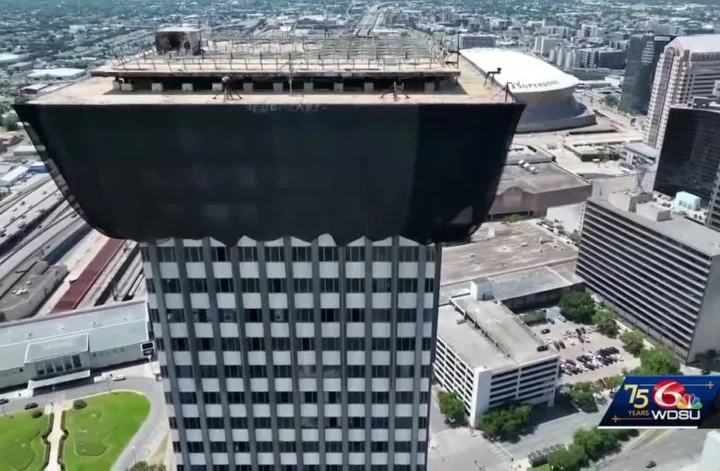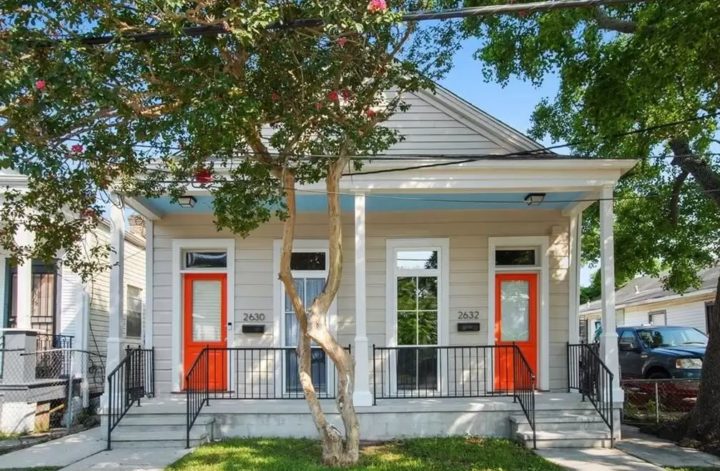Sitting empty for nearly a quarter of a century, demolition of the Plaza Tower is long-overdue.
I’m a preservationist at heart. When I see neglected properties around New Orleans, my inclination almost always leans heavily toward restoration or adaptive reuse. In most cases, abandoned structures have the potential to thrive again, breathing new life into the community. Everything from derelict gas stations and fast-food restaurants to deconsecrated churches is capable of resurrection. I’ve seen it happen. But sometimes a building outlives its usefulness and can never be revived. Sometimes it’s a blight, a canker on the face of the neighborhood and a threat to the people who live, work and visit our city. One such building is Plaza Tower.
Construction of the Plaza Tower began in 1964 and was completed in 1969. It was designed by Leonard R. Spangenberg, Jr., a local architect who apprenticed under Frank Lloyd Wright. Though every project faces complications, the fate of the tower seemed doomed from the beginning. Sam Recile, the original real estate developer who wanted to build the tower, ran into financial difficulties and was sued by the architectural firm Leonard R. Spangenberg Jr. & Associates for over half a million dollars in unpaid fees. Additionally, many criticized its construction, deeming the design an “eyesore” that detracted from the surrounding historical architecture.
In its design, Spangenberg intended to blend modernism, expressionism, futurism and constructivism – a failed attempt according to critics. In an essay published by the Society of Architectural Historians, authors Karen Kingsley and Lake Douglas describe the Plaza Tower as “a jumble rather than a distillation” of the modern disciplines. “The curved wall, intended to echo the course of the Mississippi River, and the prowlike glass corner give it the semblance of a ship about to sail off into the future.” Since the Plaza was built, many residents disdainfully refered to it as the “air traffic control tower” due to its austere, function-forward design and top-heavy hat, which was originally intended to feature a helipad.
Vocal opponents and a mid-build lawsuit resulting in a change of ownership weren’t the Plaza Tower’s only hurdles. In 1965 Hurricane Betsy struck while the tower was still under construction, and the sustained winds of over 110 mph reputedly twisted the elevator shaft, an issue that plagued the building’s elevator operations throughout its existence. On the bright side, when construction was completed, the 45-story, 531-foot Plaza Tower was the tallest skyscraper in the New Orleans skyline, until the Hancock Whitney Center (formerly One Shell Square) was completed three years later in 1972.
After the Plaza Tower was completed in 1969, it was intended primarily as office space with some residential units near the top. Oddly enough, very little residential space was made available and, as it turned out, few people were interested in living at the top of the 45-story tower – despite the views it commanded. As a result, the remaining living areas were made into offices in the mid-80s.
The multi-million dollar tower’s vitality was short-lived, serving mainly as offices for state and city employees. In 2001, several class action lawsuits were filed against the building’s owners and managers due to a lack of maintenance, exposing tenants to asbestos and toxic mold. Only a year later, the building was vacated en masse and has sat empty ever since, even though the structure underwent environmental remediation from 2008 to 2010 under the ownership of Plainfield Asset Management.
The owners of the Plaza Tower have been many and varied, from Giannasca Development Group and Bahar Development of Ohio (who were temporarily successful in their $6.5 million renovation) to Plainfield Asset Management, a now-defunct hedge fund in Connecticut. Bryan Burns, a partner with JSW Plaza Tower, purchased the building in 2011 for $650,000 and had grand plans to develop it into a mixed use space with high end apartments and commercial space, a move which would happen in conjunction with the blossoming South Market District on Loyola Avenue. Unfortunately, those lofty plans never came to fruition.
In 2014, the tower was purchased by Joe Jaeger, a local real estate developer known for buying up neglected properties for renovation or letting them sit and deteriorate before selling them to another interested buyer. Since Jager purchased it in 2014, the Plaza Tower has sat untouched for over a decade.
Over the years of neglect, the tower fell further into disrepair, and no matter how many barriers were erected, it became a haven for danger-seekers, graffiti artists, and squatters. It was only a matter of time before the crumbling structure became a danger. It began in early summer 2021 when high winds dislodged a large piece of paneling which fell and injured a passing bicyclist. Several months later in January of 2022, a fire broke out after witnesses reported seeing smoke coming from the tower. Then in April of 2023, a two-alarm “trash fire” broke out on the second floor and only hours after the fire, police discovered a homeless man who fell from the tower and died.
Though netting was installed around the Plaza’s crown to catch falling debris, the move was only a temporary stopgap. In 2023, Mayor LaToya Cantrell took aim at the city’s blighted properties, levying fines against the owners and threatening demolition. Plaza Tower definitely topped her “dirty dozen” list, along with other neglected buildings such as the Lindy Boggs Hospital on Norman C. Francis Parkway and State Palace Theater on Canal Street.
In 2024, the Governmental Affairs Committee of the New Orleans City Council approved $2.7 million in funding toward stabilization, securing the building against future accidents. More inspiring, just this past January a judge ruled the city can go forward with plans to eventually demolish the ill-fated tower, a move that came after more legal tug of war between Jaeger and the city of New Orleans.
In anticipation of Super Bowl LIX, the city invested in beautification projects, from costly, color-changing LED lights on the Crescent City Connection and Disney-like projections on the St. Louis Cathedral, to expansive murals on the Entergy substation and Girod Street overpass. As demolition of the Plaza Tower obviously couldn’t happen before the football festivities, the Super Bowl Host Committee wrapped the first ten floors with artwork. But an artistic band-aid won’t long hide the decay that has plagued the city’s skyline for decades.
*Article originally published in the April 2025 issue of Where Y’at Magazine



